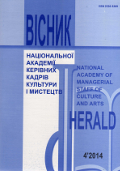ФОЛЬКЛОРНІ МУЗИЧНІ ТРАДИЦІЇ У WORLD MUSIC (НА ПРИКЛАДІ ГРУПИ "DAT")
DOI:
https://doi.org/10.32461/2226-3209.4.2014.138301Ключові слова:
World music, фольклор, мелодія, ритмАнотація
У статті аналізуються особливості одного з провідних напрямів музичної культури XX – початку XXI ст. – World music. Його основу складають найбільш давні, архаїчні шари фольклору різних країн світу. В композиціях групи "DAT" поєднуються ритмічні, ладові елементи африканського фольклору, а в інтонаціях, мелодиці, типі голосоведіння та лексиці простежується зв'язок з українськими народними піснями. Саме завдяки синтезу різних етнічних, навіть абсолютно протилежних традицій виникають неповторні мистецькі зразки в рамках World music.
##submission.downloads##
Опубліковано
Номер
Розділ
Ліцензія
Автори, які публікуються у цьому журналі, погоджуються з наступними умовами:
1. Автори залишають за собою право на авторство своєї роботи та передають журналу право першої публікації цієї роботи на умовах ліцензії Creative Commons Attribution License International CC-BY, котра дозволяє іншим особам вільно розповсюджувати опубліковану роботу з обов'язковим посиланням на авторів оригінальної роботи та першу публікацію роботи у цьому журналі.
2. Автори мають право укладати самостійні додаткові угоди щодо неексклюзивного розповсюдження роботи у тому вигляді, в якому вона була опублікована цим журналом (наприклад, розміщувати роботу в електронному сховищі установи або публікувати у складі монографії), за умови збереження посилання на першу публікацію роботи у цьому журналі.
3.Політика журналу дозволяє і заохочує розміщення авторами в мережі Інтернет (наприклад, у сховищах установ або на особистих веб-сайтах) рукопису роботи, як до подання цього рукопису до редакції, так і під час його редакційного опрацювання, оскільки це сприяє виникненню продуктивної наукової дискусії та позитивно позначається на оперативності та динаміці цитування опублікованої роботи.

